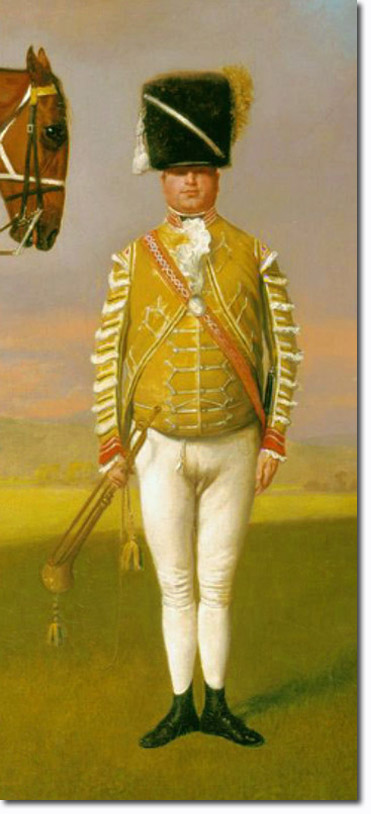|
|


|
|
The painting of the 10th Light Dragoons by George Stubbs includes the startling figure of a stout trumpeter. He may be the Trumpet Major which would explain the silver braid on his uniform. At this time it was customary for musicians and drummers to wear reverse colours to the men of the regiment. Instead of a blue uniform with deep yellow facings, he is dressed in deep yellow with red facings. The choice of red was probably determined by the former heavy dragoon trumpeter’s uniform worn before the conversion to light dragoons. It is likely that the Prince of Wales exerted his influence in the choice of this unusual outfit. Like the rest of the regiment the uniform consists of a jacket and a sleeveless shell.
The highly decorated sleeves with three-coloured lace and white tufts are part of the jacket. The lace chevrons on the sleeves and the shoulder wings of the shell have a dark centre with yellow each side and white on the outer edges. The shell comes together near the neck but his shirt frill conceals the fastening. The shirt also has frilly cuffs which are not to be seen on the other men. On his right shoulder is a red belt edged with a lace that is dark in the centre and yellow each side. There is silver decoration down the middle of the belt, and a silver belt-plate that is too indistinct but probably has the Prince of Wales Feathers on it. The belt supports a sword of some kind. The trumpeter’s headdress is a hussar busby. A circular from the Adjutant-General dated 19 Mar 1792 stated that trumpeters of all Light Dragoon regiments were to have black bearskin caps instead of hats. Regimental badges were to be placed on the front and other ornaments were to be regimental. There is no badge but the cap has a peak and silver or white cords that form a diagonal and hang as tassels on the right side. On the left side is a yellow feather plume. He holds a long brass trumpet which has yellow and blue tassels. When mounted he would wear knee boots but in dismounted order, as seen here, he has shoes and ankle gaiters. |
Armed Forces | Art and Culture | Articles | Biographies | Colonies | Discussion | Glossary | Home | Library | Links | Map Room | Sources and Media | Science and Technology | Search | Student Zone | Timelines | TV & Film | Wargames